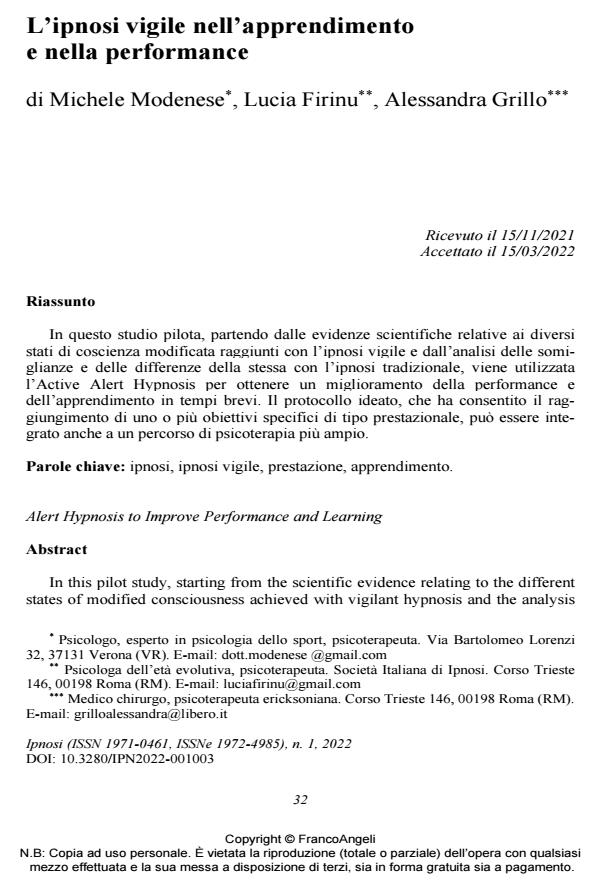Alert Hypnosis to Improve Performance and Learning
Journal title IPNOSI
Author/s Michele Modenese, Lucia Firinu, Alessandra Grillo
Publishing Year 2022 Issue 2022/1
Language Italian Pages 9 P. 32-40 File size 206 KB
DOI 10.3280/IPN2022-001003
DOI is like a bar code for intellectual property: to have more infomation
click here
Below, you can see the article first page
If you want to buy this article in PDF format, you can do it, following the instructions to buy download credits

FrancoAngeli is member of Publishers International Linking Association, Inc (PILA), a not-for-profit association which run the CrossRef service enabling links to and from online scholarly content.
In this pilot study, starting from the scientific evidence relating to the different states of modified consciousness achieved with vigilant hypnosis and the analysis of its similarities and differences with traditional hypnosis, Active Alert Hypnosis is used to obtain an improvement of performance and learning in a short time. The protocol devised, which allowed the achievement of one or more specific performance objectives, can also be integrated into a broader psychotherapy path.
Keywords: Hypnosis, Active Alert Hypnosis, Performance, Learning.
- Bànyai E. (2018). Active-Alert Hypnosis: History, Research, and Applications, American Journal of Clinical Hypnosis, 1: 88-107. DOI: 10.1080/00029157.2018.1496318
- Bànyai E., Hilgard E. (1976). A comparison of active-alert hypnotic induction with traditional relaxation induction. Journal of abnormal Psychology, 85(2): 218-224. DOI: 10.1037/0021-843X.85.2.218
- Cardena E., Alarcòn A., Capafons A., Bayot A. (1998). Effects on suggestibility of a new method of active ‒ alert hypnosis:alert hand, International Journal Of Clinical and Experimental Hypnosis, 46 (3): 280-94. DOI: 10.1080/00207149808410008
- Cesari P., Modenese M., Benedetti S., Emadi Andani M., Fiorio M. (2020) Hipnosis-induced modulation of corticospinal excitability during motor imagery. Scientific Reports, 10(1): 16882.
- Cooper L., Rodgin D. (1952). Time distorsion in hypnosis and nommotor learning, Science, 115: 500-502. DOI: 10.1126/SCIENCE.115.2992.500
- Fiorio M., Modenese M., Cesari P. (2020). The rubber hand illusion in hypnosis provides new insights into the sense of body ownership. Scientific Reports, 10: 5706.
- Kasos E. (2020). Phenomenological Experience during Active-Alert Hypnosis. Comparison of Hypnotist and Subject, International Journal of Clinical and Experimental Hypnosis, 68(4): 451-465. DOI: 10.1080/00207144.2020.1802733
- Ludwing A., Lyle W. (1964). Tension induction and hyperalert state. Journal of abnormal and social psychology, 69(1): 70-76.
- Oetting, J. (1964). Hypnosis and concentration in study. American Journal of clinical Hypnosis, 54: 96-106. DOI: 10.1080/00029157.2011.605481
- Robazza C., Bortoli L. (1995). A case study of improved performance in archery using hypnosis, Perceptual and Motor Skills, 81(2): 1364-1366.
- Téllez A., Valdez A., Sánchez-Jáuregui T. (2020). Active-Alert Hypnosis to Achieve Personal, Professional, and Therapeutic Goals, Hypnotherapy and Hypnosis.
- Wark D. (2011). Traditional and alert Hypnosis for education: a literature review, American Journal of Clinical Hypnosis, 54: 96-106. DOI: 10.1080/00029157.2011.605481
- Wark D., La Plante P. (1991). Reading in alert trance: Effects on comprehension, Hypnosis, 17(2): 90-97. DOI: 10.1080/00029157.2006.10401536
Michele Modenese, Lucia Firinu, Alessandra Grillo, L’ipnosi vigile nell’apprendimento e nella performance in "IPNOSI" 1/2022, pp 32-40, DOI: 10.3280/IPN2022-001003